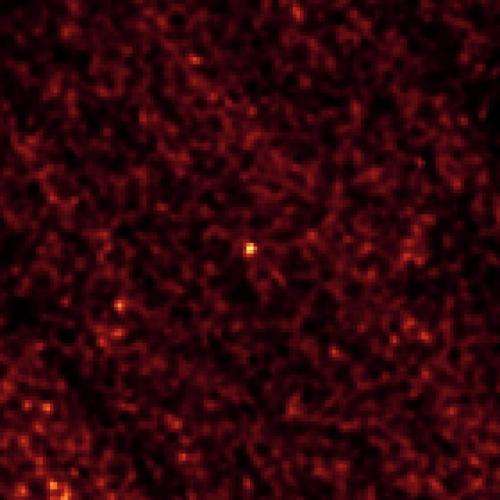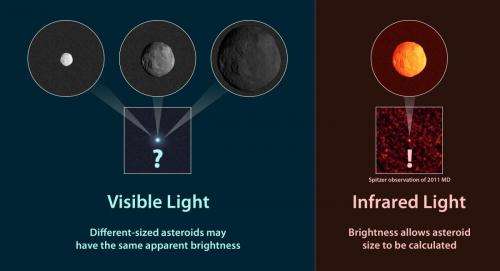Spitzer spies an odd, tiny asteroid

(Phys.org) —Astronomers using NASA's Spitzer Space Telescope have measured the size of an asteroid candidate for NASA's Asteroid Redirect Mission (ARM), a proposed spacecraft concept to capture either a small asteroid, or a boulder from an asteroid. The near-Earth asteroid, called 2011 MD, was found to be roughly 20 feet (6 meters) in size, and its structure appears to contain a lot of empty space, perhaps resembling a pile of rubble. Spitzer's infrared vision was key to sizing up the asteroid.
"From its perch up in space, Spitzer can use its heat-sensitive infrared vision to spy asteroids and get better estimates of their sizes," said Michael Mommert of Northern Arizona University, Flagstaff, lead author of a new study appearing today, June 19, in the Astrophysical Journal Letters. David Trilling, also of Northern Arizona University, leads the team of astronomers.
The Spitzer results confirm that asteroid 2011 MD has characteristics suitable for the ARM proposal, elevating it to the "valid candidate" level. Valid candidates are those asteroids with the right size, mass and rotation rate to be feasibly captured by the robotic spacecraft. Two other valid candidates have been identified so far. (The proposal to capture a boulder from an asteroid involves a different set of criteria.) NASA continues to search for and find new potential candidates using its ground-based asteroid survey programs.
Prior to the Spitzer study, the size of 2011 MD was only very roughly known. It had been observed in visible light, but an asteroid's size cannot be determined solely from visible-light measurements. In visible light alone, for example, a white snowball in space could look just as bright as a dark mountain of cosmic rock. The objects may differ in size but reflect the same amount of sunlight, appearing equally bright.

Infrared light, on the other hand, is a better indicator of an object's true size. This is because an object's infrared glow depends largely on its temperature, not its reflectivity.
From the new Spitzer data, the team was able to measure the size of asteroid 2011 MD. When the infrared and visible-light observations were combined, the asteroid's density and mass could also be measured. The density of 2011 MD is remarkably low—about the same as water, which agrees with a separate analysis of observations taken in 2011. Since rock is about three times more dense than water, this implies that about two-thirds of the asteroid must be empty space.
What does an asteroid with that much empty space look like? The team doesn't know, but proposes two possible solutions: it might be a collection of loosely bound rocks, like a fleet of flying boulders, or a solid rock with surrounding fine debris.
A similar "rubble-pile" type of composition was also found for asteroid 2009 BD, another valid candidate for ARM. Trilling and colleagues used Spitzer to help pin down the size of that asteroid to roughly 10 to 13 feet (3 or 4 meters).
In both studies, Spitzer stared at the asteroids for about 20 hours. Such long observations are scheduled more often in Spitzer's "warm" mission, a phase that began in 2009 when the spacecraft ran out of coolant, as planned. Spitzer, which still has two infrared channels that operate without coolant, now specializes in longer, targeted observing campaigns.
"With Spitzer, we have been able to get some of the first measurements of the sizes and compositions of tiny asteroids," said Trilling. "So far, we've looked at two asteroids and found both of them to be really weird—not at all like the one solid rock that we expected. We're scratching our heads."
The team says the small asteroids probably formed as a result of collisions between larger asteroids, but they do not understand how their unusual structures could have come about. They plan to use Spitzer in the future to study more of the tiny asteroids, both as possible targets for asteroid space missions, and for a better understanding of the many asteroid denizens making up our solar system.
More information: Paper: dx.doi.org/10.1088/2041-8205/789/1/L22
Journal information: Astrophysical Journal Letters
Provided by NASA





















